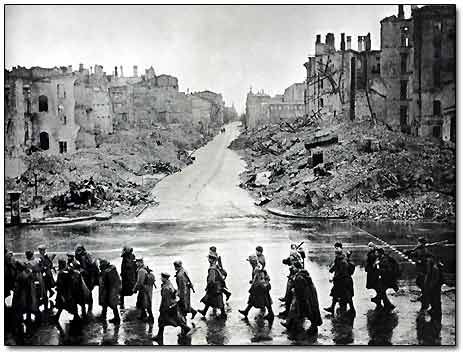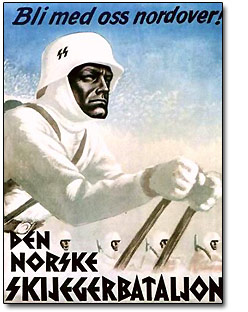World War II - Eastern Front
Autumn and Winter 1943
The Soviet juggernaut got rolling in earnest with the advance into the Germans' Orel salient. The diversion of Hitler's favorite Grossdeutschland Division from Belgorod to Karachev could not halt the tide.
Russians Attacking

Meanwhile, the 1st Panzer Army and a reconstituted 6th Army, were by August too weak to sustain a Soviet onslaught on their own front, and when the Soviets hit them they had to fall back all the way through the Donbass industrial region to the Dnieper, losing the industrial resources and half the farmland that Germany had invaded the Soviet Union to exploit. At this time Hitler agreed to a general withdrawal to the Dnieper line.
As September proceeded into October, the Germans found the Dnieper line impossible to hold as the Soviet bridgeheads grew and grew, and important Dnieper towns started to fall, with Zaporozhye the first to go, followed by Dnepropetrovsk. Finally, early in November the Soviets broke out of their bridgeheads on either side of Kiev and captured the Ukrainian capital, at that time the third largest city in the Soviet Union.
Red Army Forces in Kiev, Ukraine

The Soviet advance continued along the railway line until the 1939 Polish-Soviet border was reached on 3 January 1944.
Pre-War Soviet Border Restored

In the South, 3rd Ukrainian Front went over to the offensive in March. Having already isolated the Crimea peninsula by severing the neck of the Perekop isthmus, Soviet forces advanced across the mud to the Romanian border, not stopping on the river Prut. 4th Ukrainian Front recaptured the Crimea in April 1944.

Nazi Recruiting Poster
for SS Ski Battalion
"Join Us in
the North!"
On Army Group North's front, there was barely any fighting at all until January 1944, when out of nowhere Volkhov and Second Baltic Fronts struck. In a lightning campaign, Leningrad was liberated and Novgorod was recaptured; by February the Red Army had reached the borders of Estonia after a 75-mile advance.
The huge force fell on the sector of SS-Obergruppenfüher Felix Steiner's III (Germanic) SS Panzer Corps, hitting the area of the 9th and 10th Luftwaffe Field Divisions. The Luftwaffe units crumbled quickly, and soon Army Group North was falling back to new positions around the Narva river in Estonia.
Steiner's corps was mostly made up of SS Freiwilligen or volunteer formations. SS men from Scandinavia, Belgium, France, The Netherlands, Hungary, Romania, Italy, Spain and the Baltic States joined German formations in the defense of the river line.
Despite heavy losses and several setbacks, the Soviets kept up constant probing attacks all across the Narva line. On 23 March, Hitler ordered the creation of Festung Narva (Fortress Narva). Narva was to become a fortress city and was to be held at all costs.